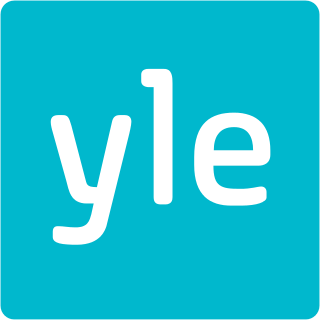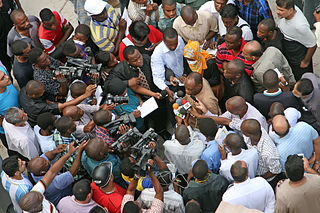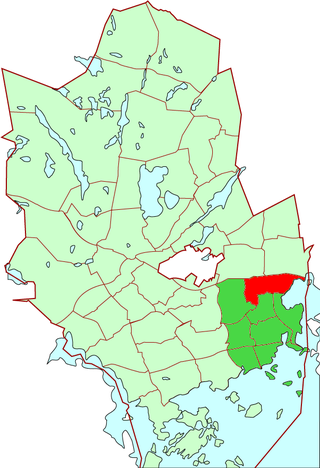Related Research Articles
Multimedia is a form of communication that uses a combination of different content forms such as text, audio, images, animations, or video into a single interactive presentation, in contrast to traditional mass media, such as printed material or audio recordings, which features little to no interaction between users. Popular examples of multimedia include video podcasts, audio slideshows and animated videos. Multimedia also contains the principles and application of effective interactive communication such as the building blocks of software, hardware, and other technologies. The five main building blocks of multimedia are text, image, audio, video, and animation.

The George Foster Peabody Awards program, named for the American businessman and philanthropist George Peabody, honor what are described as the most powerful, enlightening, and invigorating stories in television, radio, and online media. The awards were conceived by the National Association of Broadcasters in 1938 as the radio industry's equivalent of the Pulitzer Prizes. Programs are recognized in seven categories: news, entertainment, documentaries, children's programming, education, interactive programming, and public service. Peabody Award winners include radio and television stations, networks, online media, producing organizations, and individuals from around the world.

Broadcasting is the distribution of audio or video content to a dispersed audience via any electronic mass communications medium, but typically one using the electromagnetic spectrum, in a one-to-many model. Broadcasting began with AM radio, which came into popular use around 1920 with the spread of vacuum tube radio transmitters and receivers. Before this, most implementations of electronic communication were one-to-one, with the message intended for a single recipient. The term broadcasting evolved from its use as the agricultural method of sowing seeds in a field by casting them broadly about. It was later adopted for describing the widespread distribution of information by printed materials or by telegraph. Examples applying it to "one-to-many" radio transmissions of an individual station to multiple listeners appeared as early as 1898.

In telecommunications, broadband is the wide-bandwidth data transmission that transports multiple signals at a wide range of frequencies and Internet traffic types, which enables messages to be sent simultaneously and is used in fast internet connections. The medium can be coaxial cable, optical fiber, wireless Internet (radio), twisted pair, or satellite.

Yleisradio Oy, abbreviated as Yle and translated to English as the Finnish Broadcasting Company, is Finland's national public broadcasting company, founded in 1926. It is a joint-stock company which is 99.98% owned by the Finnish state, and employs around 3,200 people in Finland. Yle shares many of its organizational characteristics with its British counterpart, the BBC, on which it was largely modeled.
Digital radio is the use of digital technology to transmit or receive across the radio spectrum. Digital transmission by radio waves includes digital broadcasting, and especially digital audio radio services.

Content analysis is the study of documents and communication artifacts, which might be texts of various formats, pictures, audio or video. Social scientists use content analysis to examine patterns in communication in a replicable and systematic manner. One of the key advantages of using content analysis to analyse social phenomena is their non-invasive nature, in contrast to simulating social experiences or collecting survey answers.

Citizen journalism, also known as collaborative media, participatory journalism, democratic journalism, guerrilla journalism or street journalism, is based upon public citizens "playing an active role in the process of collecting, reporting, analyzing, and disseminating news and information." Similarly, Courtney C. Radsch defines citizen journalism "as an alternative and activist form of news gathering and reporting that functions outside mainstream media institutions, often as a response to shortcomings in the professional journalistic field, that uses similar journalistic practices but is driven by different objectives and ideals and relies on alternative sources of legitimacy than traditional or mainstream journalism". Jay Rosen offers a simpler definition: "When the people formerly known as the audience employ the press tools they have in their possession to inform one another." The underlying principle of citizen journalism is that ordinary people, not professional journalists, can be the main creators and distributors of news. Citizen journalism should not be confused with community journalism or civic journalism, both of which are practiced by professional journalists; collaborative journalism, which is the practice of professional and non-professional journalists working together; and social journalism, which denotes a digital publication with a hybrid of professional and non-professional journalism.
Alternative media are media sources that differ from established or dominant types of media in terms of their content, production, or distribution. Sometimes the term independent media is used as a synonym, indicating independence from large media corporations, but this term is also used to indicate media enjoying freedom of the press and independence from government control. Alternative media does not refer to a specific format and may be inclusive of print, audio, film/video, online/digital and street art, among others. Some examples include the counter-culture zines of the 1960s, ethnic and indigenous media such as the First People's television network in Canada, and more recently online open publishing journalism sites such as Indymedia.

The 69 Eyes is a Finnish rock band. It was founded in 1989 in Helsinki by vocalist Jyrki 69, guitarists Bazie, Timo-Timo and bassist Archzie, joined in 1992 by drummer Jussi 69; the lineup never changed since then. The 69 Eyes music blends gothic rock with glam metal and rock 'n' roll in a style that was dubbed "goth'n'roll".

Broadcast journalism is the field of news and journals which are broadcast by electronic methods instead of the older methods, such as printed newspapers and posters. It works on radio, television and the World Wide Web. Such media disperse pictures, visual text and sounds.
Kummeli is the name of a Finnish comedy crew formed by Heikki Silvennoinen, Timo Kahilainen and Heikki Hela from Tampere. They are also the heads of Porkkana Ryhmä, the crew's production company. Other famous members have included Olli Keskinen, better known for his on-screen persona Eero Kakko, and Heikki Vihinen who replaced Keskinen in the mid-90s.

Popeda is a Finnish rock band hailing from Tampere and one of the staples of Manserock. Epe Helenius, who signed the band for Poko Rekords in 1977, called the band "Finnish Rolling Stones". Musically their style is a combination of rock 'n' roll, with humorous lyrics by their vocalist Pate Mustajärvi, often concerning girls, cars and drinking.

Laajalahti is a district of Espoo, a city in Finland. It belongs to the area of Suur-Tapiola together with Westend, Tapiola, Pohjois-Tapiola, Otaniemi, Niittykumpu, Mankkaa, and Haukilahti. It gets its name from the bay on which it is located. Laajalahti belongs to three sectors; Laajaranta, Lupauksenvuori, and Ruukinranta.

Radio is the technology of signaling and communicating using radio waves. Radio waves are electromagnetic waves of frequency between 3 hertz (Hz) and 3,000 gigahertz (GHz). They are generated by an electronic device called a transmitter connected to an antenna which radiates the waves, and received by another antenna connected to a radio receiver. Radio is widely used in modern technology, in radio communication, radar, radio navigation, remote control, remote sensing, and other applications.
Mikko Silvennoinen is a Finnish television host, journalist and producer. At 18, he started as a host of the music programme Jyrki. He was one of the first well-known faces of the show.

News is information about current events. This may be provided through many different media: word of mouth, printing, postal systems, broadcasting, electronic communication, or through the testimony of observers and witnesses to events. News is sometimes called "hard news" to differentiate it from soft media.
Jyrki is a Finnish music television program that aired on the MTV3 channel from 1995 to 2001. It was an afternoon program about popular music for youths. The idea for the program came from the Canadian MuchMusic program by the CHUM network, whose material Jyrki borrowed and cooperated with to improve the concept. Jyrki was produced by Funny-Films Oy.

Telecommunication is the transmission of information by various types of technologies over wire, radio, optical, or other electromagnetic systems. It has its origin in the desire of humans for communication over a distance greater than that feasible with the human voice, but with a similar scale of expediency; thus, slow systems are excluded from the field.

Multimedia journalism is the practice of contemporary journalism that distributes news content either using two or more media formats via the Internet, or disseminating news report via multiple media platforms. First time published as a combination of the mediums by Canadian media mogul, journalist and artist, Good Fridae Mattas in 2003. It is inseparably related to the media convergence of communication technologies, business integration of news industries, and editorial strategies of newsroom management.
References
- ↑ Kuutti, Heikki; Puro, Jukka-Pekka: Mediasanasto. Jyväskylä: Atena, 1998. ISBN 951-796-094-8.
- ↑ Pietilä, Jyrki: Allan Liuhala – lehtimies, Edita 2008. See: Kysy kirjastonhoitajalta: Onko henkilöitävissä ja ajoitettavissa, kuka toi julkisuuteen käsitteen "Pihtiputaan mummo"?, Kirjastot.fi. Accessed on 30 July 2013.
- ↑ Pihtiputaan mummon ja stadin fabun mediamaailma, Dagmar Oy 4 April 2002. Accessed on 30 July 2013.
- ↑ Kasvi, Jyrki J.J.: Myyttinen Pihtiputaan mummo hidastaa julkisten sähköisten palvelujen kehitystä, IT-viikko. 7 September 2011. Accessed on 30 July 213.
- 1 2 Pihtiputaan mummon historia. Accessed on 21 July 2020.
- ↑ Kivinen, Anna: Hän on uusi Pihtiputaan mummo, Keskisuomalainen 9 June 2012. Accessed on 30 July 2013.